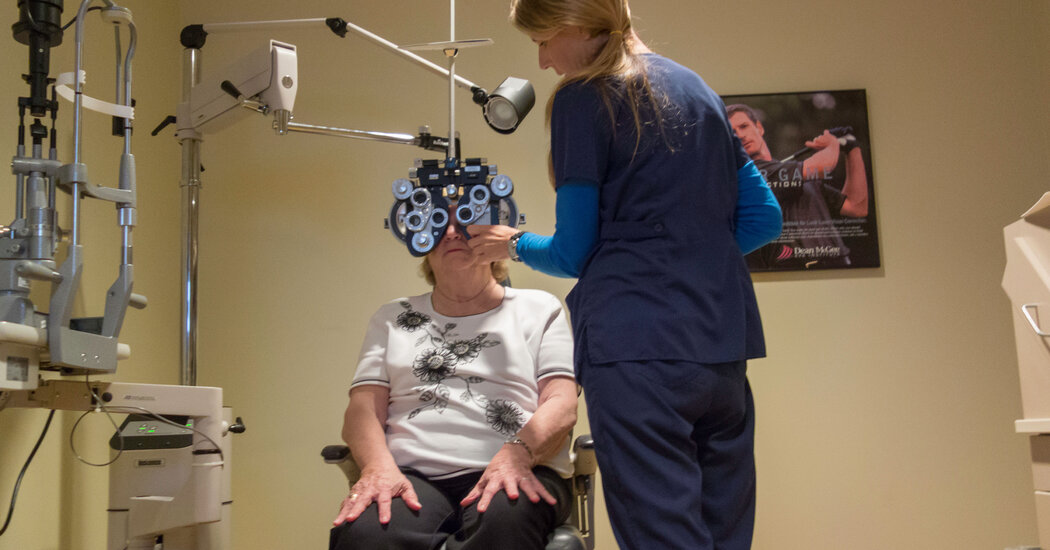Researchers: Improving Eyesight May Help Prevent Dementia

[ad_1]
Dementia cases are climbing along with an aging world population, and yet another much-anticipated Alzheimer’s medication, crenezumab, has proved ineffective in clinical trials — the latest of many disappointments. Public health experts and researchers argue that it is past time to turn our attention to a different approach — focusing on eliminating a dozen or so already known risk factors, like untreated high blood pressure, hearing loss and smoking, rather than on an exorbitantly priced, whiz-bang new drug.
“It would be great if we had drugs that worked,” said Dr. Gill Livingston, a psychiatrist at University College London and chair of the Lancet Commission on Dementia Prevention, Intervention and Care. “But they’re not the only way forward.”
Emphasizing modifiable risks — things we know how to change — represents “a drastic change in concept,” said Dr. Julio Rojas, a neurologist at the University of California, San Francisco. By focusing on behaviors and interventions that are already widely available and for which there is strong evidence, “we are changing how we understand the way dementia develops,” he said.
The latest modifiable risk factor was identified in a study of vision impairment in the United States that was published recently in JAMA Neurology. Using data from the Health and Retirement Study, the researchers estimated that about 62 percent of current dementia cases could have been prevented across risk factors and that 1.8 percent — about 100,000 cases — could have been prevented through healthy vision.
Though that’s a fairly small percentage, it represents a comparatively easy fix, said Dr. Joshua Ehrlich, an ophthalmologist and population health researcher at the University of Michigan and the study’s lead author.
That’s because eye exams, eyeglass prescriptions and cataract surgery are relatively inexpensive and accessible interventions. “Globally, 80 to 90 percent of vision impairment and blindness is avoidable through early detection and treatment, or has yet to be addressed,” Dr. Ehrlich said.
The influential Lancet Commission began leading the modifiable risk factor movement in 2017. A panel of doctors, epidemiologists and public health experts reviewed and analyzed hundreds of high-quality studies to identify nine risk factors accounting for much of the world’s dementia: high blood pressure, lower education levels, impaired hearing, smoking, obesity, depression, physical inactivity, diabetes and low levels of social contact.
In 2020, the commission added three more: excessive alcohol consumption, traumatic brain injuries and air pollution. The commission calculated that 40 percent of dementia cases worldwide could theoretically be prevented or delayed if those factors were eliminated.
“A massive change could be made in the number of people with dementia,” said Dr. Livingston. “Even small percentages — because so many people have dementia and it’s so expensive — can make a huge difference to individuals and families, and to the economy.”
In fact, in wealthier countries, “it’s already happening as people get more education and smoke less,” she pointed out. Because the odds of dementia increase with age, as more people reach older ages, the number of dementia cases keeps rising. But the proportions are dropping in Europe and North America, where the incidence of dementia has fallen by 13 percent per decade over the past 25 years.
Dr. Ehrlich hopes the Lancet Commission will add vision impairment to its list of modifiable risks when it updates its report, and Dr. Livingston said it would indeed be on the commission’s agenda.
Why would hearing and vision loss contribute to cognitive decline? “A neural system maintains its function through stimulation from sensory organs,” explained Dr. Rojas, a co-author of an accompanying editorial in JAMA Neurology. Without that stimulation, “there will be a dying out of neurons, a rearrangement of the brain,” he said.
Hearing and vision loss could also affect cognition by limiting older adults’ participation in physical and social activity. “You can’t see the cards, so you stop playing with friends,” Dr. Ehrlich said, “or you stop reading.”
The link between dementia and hearing loss, the single most important factor the Lancet Commission cited as a modifiable risk, has been well established. There is less clinical data on the connection to impaired vision, but Dr. Ehrlich is a co-investigator of a study in southern India to see whether providing older adults with eyeglasses affects cognitive decline.
Of course, this approach to reducing dementia is “aspirational,” he acknowledged: “We’re not going to eliminate low education, obesity, all of these.”
Some efforts, like raising education levels and treating high blood pressure, should begin in youth or at midlife. Others require major policy changes; it’s hard for an individual to control air pollution, for example. Altering habits and making lifestyle changes — like stopping smoking, reducing drinking and exercising regularly — are not simple.
Even fairly routine medical practices, like measuring and monitoring high blood pressure and taking drugs to control it, can be difficult for low-income patients.
Moreover, older Americans will be likely to notice that routine vision and hearing care are two services that traditional Medicare does not cover.
It will pay for care related to diabetic retinopathy, glaucoma or age-related macular degeneration, and it covers cataract surgery. But for more common problems correctable with eyeglasses, “traditional Medicare is not going to help you out much,” said David Lipschutz, associate director of the nonprofit Center for Medicare Advocacy. Nor will it cover most hearing aids or exams, which are much higher expenses.
Medicare Advantage programs, provided through private insurers, usually do include some vision and hearing benefits, “but look at the scope of coverage,” Mr. Lipschutz cautioned. “They might apply $200 or $300 or $500 towards hearing aids” — but at a typical $3,000 to $5,000 a pair, “they still might be far out of reach,” he said.
Expanding traditional Medicare to include hearing, vision and dental benefits was part of the Biden administration’s Build Back Better Act. But after the House passed it in November, Republicans and Senator Joe Manchin III, a Democrat, scuttled it in the Senate.
Still, despite the caveats and cautions, reducing modifiable risk factors for dementia could have enormous payoff, and the Centers for Disease Control and Prevention has incorporated that approach into its National Plan to Address Alzheimer’s Disease.
A focus on these factors could also help reassure older Americans and their families. Some important risks for dementia lie beyond our control — genetics and family history, and advancing age itself. Modifiable factors, however, are things we can act on.
“People have such fears of developing dementia, losing your memory, your personality, your independence,” Dr. Livingston said. “The idea that you can do a lot about it is powerful.”
Even delaying its onset can have a great effect. “If, instead of getting it at 80, you get it at 90, that’s a huge thing,” she said.
Eye and hearing exams, exercise, weight control, stopping smoking, blood pressure medications, diabetes care — “we’re not talking about expensive interventions or fancy surgery or seeing specialists who are hours away,” Dr. Ehrlich added. “These are things people can do in the communities where they live.”
[ad_2]




